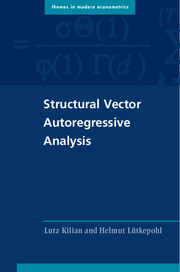Book contents
- Frontmatter
- Contents
- Preface
- 1 Introduction
- 2 Vector Autoregressive Models
- 3 Vector Error Correction Models
- 4 Structural VAR Tools
- 5 Bayesian VAR Analysis
- 6 The Relationship between VAR Models and Other Macroeconometric Models
- 7 A Historical Perspective on Causal Inference in Macroeconometrics
- 8 Identification by Short-Run Restrictions
- 9 Estimation Subject to Short-Run Restrictions
- 10 Identification by Long-Run Restrictions
- 11 Estimation Subject to Long-Run Restrictions
- 12 Inference in Models Identified by Short-Run or Long-Run Restrictions
- 13 Identification by Sign Restrictions
- 14 Identification by Heteroskedasticity or Non-Gaussianity
- 15 Identification Based on Extraneous Data
- 16 Structural VAR Analysis in a Data-Rich Environment
- 17 Nonfundamental Shocks
- 18 Nonlinear Structural VAR Models
- 19 Practical Issues Related to Trends, Seasonality, and Structural Change
- Bibliography
- Notation and Abbreviations
- Author Index
- Subject Index
15 - Identification Based on Extraneous Data
Published online by Cambridge University Press: 13 November 2017
- Frontmatter
- Contents
- Preface
- 1 Introduction
- 2 Vector Autoregressive Models
- 3 Vector Error Correction Models
- 4 Structural VAR Tools
- 5 Bayesian VAR Analysis
- 6 The Relationship between VAR Models and Other Macroeconometric Models
- 7 A Historical Perspective on Causal Inference in Macroeconometrics
- 8 Identification by Short-Run Restrictions
- 9 Estimation Subject to Short-Run Restrictions
- 10 Identification by Long-Run Restrictions
- 11 Estimation Subject to Long-Run Restrictions
- 12 Inference in Models Identified by Short-Run or Long-Run Restrictions
- 13 Identification by Sign Restrictions
- 14 Identification by Heteroskedasticity or Non-Gaussianity
- 15 Identification Based on Extraneous Data
- 16 Structural VAR Analysis in a Data-Rich Environment
- 17 Nonfundamental Shocks
- 18 Nonlinear Structural VAR Models
- 19 Practical Issues Related to Trends, Seasonality, and Structural Change
- Bibliography
- Notation and Abbreviations
- Author Index
- Subject Index
Summary
Yet another approach to identifying structural VAR shocks is to rely on additional data not included among the VAR model variables. This chapter discusses two such approaches. The first approach relies on information from high-frequency futures prices, whereas the second approach relies on external exogenous instruments such as measures of exogenous OPEC oil supply shocks or the narrative measures of exogenous monetary policy shocks and exogenous fiscal policy shocks already discussed in Chapter 7.
Identification Based on High-Frequency Futures Prices
Discomfort with semistructural VAR models of monetary policy, in which the monetary policy shock is identified based on a recursive ordering of the model variables, has stimulated the development of yet another approach to identification that relies on high-frequency futures market data to identify monetary policy shocks. One motivation for this approach is that the sequences of policy shocks identified by recursive structural VAR models do not always correspond to common perceptions of when policy shocks occurred and indeed vary widely across models (see Rudebusch 1998).
The other motivation is that the reduced-form interest rate forecasts of conventional VAR models of monetary policy are difficult to reconcile with financial market measures of interest rate expectations. For example, Rudebusch (1998) documents a low correlation between the quarterly reduced-form prediction errors for the federal funds rate implied by conventional VAR models of monetary policy and the quarterly changes in the expected federal funds rate implied by the prices of federal funds futures contracts, defined as
where quarter t contains months, and is the actual federal funds rate in month i, and denotes the j-months ahead expected federal funds rate at the end of month i, as measured by the price of the federal funds futures contract. The financial market shocks statistically explain only between 10% and 25% of the variation in the quarterly VAR prediction errors, based on data since 1988 when federal funds futures contracts were introduced. Rudebusch interprets this evidence as suggesting that the reduced-form representation of VAR models of monetary policy is inherently misspecified, perhaps reflecting an informational deficiency of these models (see also Chapter 16).
Information
- Type
- Chapter
- Information
- Structural Vector Autoregressive Analysis , pp. 532 - 548Publisher: Cambridge University PressPrint publication year: 2017
